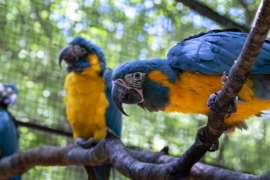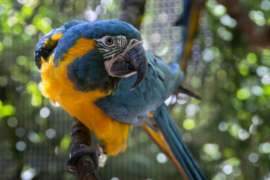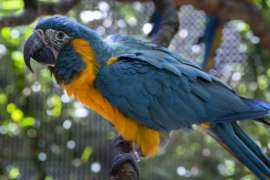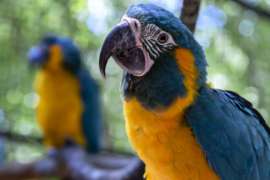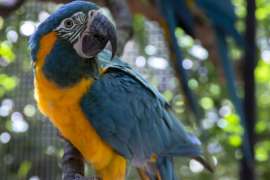Blue-throated Macaw
Blue-throated Macaw
Blue-throated macaws are often called barba azul in Spanish, meaning “blue beard,” because of the bright blue coloration covering their throats. They play an important role in the ecosystem as seed dispersers. These intelligent and colorful birds are critically endangered and threatened by habitat loss and the illegal pet trade.
Ara glaucogularis
Frugivore
South America
Forests, Grasslands
These birds love to climb so be sure to look up at the branches. With their loud vocalizations, you may hear them well before reaching the habitat!
Photos and Videos
Unlike other species of macaws, blue-throated macaws are not often seen in large flocks. They may appear in small groups of 10 or fewer, but this may be due to there being so few in the wild. While they primarily travel by flying, blue-throated macaws can also climb trees and walk on the ground. Macaws are known for their loud, screeching alarm calls that they make when threatened or frightened. Their bright coloration provides them with camouflage in the wild, allowing them to blend in with bright fruits, leaves and shadows.
Macaws are very intelligent birds with large brains. They are naturally curious and manipulate objects well, though tool use is rare in wild parrot species. Blue-throated macaws perform better than primates on some decision-making tasks, demonstrating that they can inhibit impulsive reactions to get more valuable food rewards in an experimental setting. Macaws, including blue-throated macaws, also play an important role as seed dispersers in their environment. They are the main dispersers of the Motacú palm, the trees they prefer to nest in.
Blue-throated macaws get their name from the vivid blue coloration covering their throat and are often called barba azul in Spanish, meaning “blue beard.” Their heads, backs, and outsides of wings and tails are the same blue color, while the sides of their faces and chests are a bright yellow-gold.
Blue-throated macaws will mate for life. They are sexually mature at 2-4 years and breed once a year. Interestingly, they do not make their own nests, but find cavities in trees that have already been created by grubs that eat and hollow out dead Motacú palms. Mated pairs will often pick a different nesting site each year. Females incubate the eggs while the males bring them food. Once the chicks have hatched, both parents will bring food back to the nest. The chicks will fledge and be ready for their first attempt at flight at 13-14 weeks, but they will stay with their parents for up to a year. In both the wild and here at the Zoo, the blue-throated macaw has a lifespan of up to 50 years, meaning one female could produce 100+ chicks across her lifetime!
These birds love to climb so be sure to look up at the branches. With their loud vocalizations, you may hear them well before reaching the habitat!
There are two populations, both within Bolivia. One lives north of the city of Trinidad, and the other lives to the south of Trinidad. They inhabit a total area of around 968 square miles.
The Beni savanna, a critically endangered ecosystem, is a flooded savanna with Motacú palm tree islands, where the blue-throated macaw forages and nests.
Their herbivorous diet consists primarily of Motacú palm fruits, seeds, grains, nuts and leaves in the wild. At the Zoo, they mostly are fed fruits, berries, seeds, nuts, cut-up vegetables, and bird biscuits containing vitamins and minerals.
With only around 400 blue-throated macaws left in the wild, immediate conservation action is critical for this species. Threats to these charismatic birds include illegal pet trade and habitat loss for logging and cattle ranching. There are very few old stands of the dead palms they nest in remaining since the land is being cleared, so they face a lack of viable nesting sites. Additionally, climate change threatens the blue-throated macaw by causing increased storms and flooding in their range. The blue-throated macaw is considered the rarest species of macaw in the world. They are a vital part of the ecosystem of the Beni savanna and life cycle of the Motacú palm tree since they are this trees’ main seed disperser. Losing the species that fills this role will affect the forests, which humans depend on for food, lumber and other resources.
Zoo Atlanta supports blue-throated macaw conservation efforts by Association Armonia through our Quarters for Conservation initiative for the 2019 – 2020 project cycle. Association Armonia established Barba Azul Nature Reserve, the world’s first protected habitat for the macaw in northern Bolivia. Preserving this critically endangered ecosystem not only protects the blue-throated macaw, but also neighboring species like jaguars, pumas and maned wolves. The association’s community-centered approach works to educate and engage local people in protecting macaws from poaching, rather than exploiting the birds in the illegal pet trade and decorative feather trade. Blue-throated macaws were thought to be extinct due to trapping for the pet trade, but a small population was rediscovered in 1992.
Zoo Atlanta’s blue-throated macaws are part of the Association of Zoos and Aquariums’ (AZA) Species Survival Plan® (SSP), which maintains genetic diversity of a species within a zoological population and ensures that animal populations remain self-sustaining for future generations. The main threat facing blue-throated macaws is habitat loss, but you can help at home by using sustainably-sourced paper products. Learn more at Association Armonia’s website.

